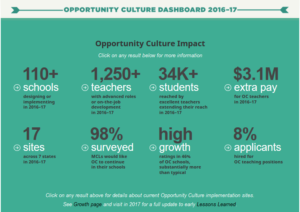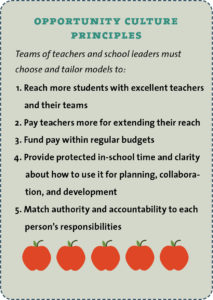
Curious about the impact of an Opportunity Culture®? We’ve just updated our dashboard, as we will every year, with the latest statistics. Such as:
- 110+ schools at 17 sites in 7 states—and growing
- 34,000+ students taught by teachers extending their reach—a 50 percent increase from 2015–16
- 1,250+ teachers with advanced roles or on-the-job development—a 50 percent increase, too
- Average pay supplements over $12,000, up more than $1,300 in one year
- $3.1 million in extra pay for teachers via supplements funded sustainably through reallocation
- Just 8.2% of applicants for Opportunity Culture® advanced positions were hired
- High growth for 46 percent of Opportunity Culture® schools—a much higher percentage than among typical schools
- Far fewer schools than typical made low growth (12%)

Districts that adhered closely and robustly to the five Opportunity Culture® Principles exceeded growth targets in a far larger percentage of schools.
Public Impact®, which created and leads the Opportunity Culture® national initiative, updates the dashboard to describe implementation, show progress, and highlight areas for improvement of participating districts and schools.
The third year of OC implementation produced exciting results, along with lessons, in these still-early years of implementation.
More details from 2016–17:
- Schools: The number of Opportunity Culture® (OC) schools increased 32 percent from last year, with more than 110 schools either implementing in 2016–17 or designing their OC plans for fall 2017–18. The initiative began in 2013–14 with 7 schools. Nine more districts and charter school organizations are already considering launch of Opportunity Culture® this winter.
- Students—More than 34,000 unique students are reached by one or more OC teachers, as the number of Opportunity Culture® roles per school continued to increase
- Teaching Roles—253 teachers are in advanced roles; 1,043 are receiving on-the-job development on teacher-led teams
- Teachers—In anonymous surveys, 98 percent of multi-classroom leaders said they want OC to continue in their schools. 93–98% percent agree that they have new leadership opportunities, pay, and the chance to reach more students. 89 percent of all OC staff agree that they receive feedback to improve their teaching. In Syracuse, the first collective bargaining site, teacher satisfaction was high, like other sites nationally, and the teachers union and district continue to collaborate.
- Pay—$3.1 million was reallocated nationally to higher teacher pay in 2016–17; $6.6 million has been reallocated since OC began in 2013. The average supplement for roles intended for excellent teachers was $12,370—an increase of $1,370 from the previous year—with a top supplement of $23,000.
- Teacher Recruitment—Opportunity Culture® aims to help districts and schools be more selective in hiring teachers: the average percentage of applicants hired for OC positions was just 8.2 percent, allowing selectivity for positions, including those in some schools that previously had large numbers of teacher vacancies.
- Student Results— In the three participating sites in North Carolina—Charlotte-Mecklenburg Schools, the Project L.I.F.T. zone within Charlotte, and Cabarrus County Schools—OC schools doubled the odds of high growth and halved the odds of low growth compared to similar schools statewide. Fidelity to the Opportunity Culture® Principles was relatively strong, and strongest in Charlotte-Mecklenburg/L.I.F.T.
In Syracuse, eight schools are implementing OC, and half started with single-digit proficiency; four of the five OC schools labeled “struggling” or “persistently struggling” in the state’s accountability system moved off the state’s receivership list, having met “demonstrable improvement plan” targets in the 2015-16 school year. Because the district’s OC schools weren’t distinguishable from others in the district on student growth, the district has already begun to increase its fidelity to the Opportunity Culture® Principles in collaboration with Public Impact®.
See the OC Dashboard for more details and analysis.
“We are delighted by the progress that Opportunity Culture® teachers have made–helping more of their colleagues succeed and helping more students excel. Public Impact®’s goal in 2017 is to provide even better guidance, based on data about our best schools and teachers, to the districts and principals supporting these amazing educators,” said Emily Ayscue Hassel, Opportunity Culture® co-founder.
Public Impact® continues to conduct an extensive analysis of all outcomes so we can continually improve our materials and work with current and future sites to achieve the twin goals of excellent teaching for all students and outstanding career opportunities and support for all teachers.
Note: Public Impact® and Opportunity Culture® are registered trademarks; Multi-Classroom Leader® is a trademarked term, registration pending.
